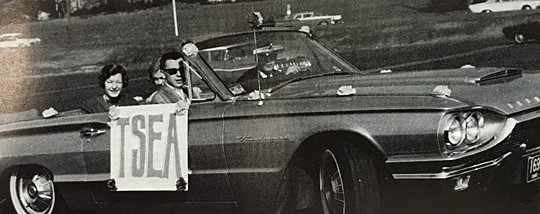A century of preparing educators: Judith Herb College of Education celebrates 100 years
By Dr. Edward A. Janak
UT associate professor and chair of foundations of education
 Throughout its history, The University of Toledo has seen its mission as fulfilling the needs of the city. The Judith Herb College of Education has demonstrated this notion for a century.
Throughout its history, The University of Toledo has seen its mission as fulfilling the needs of the city. The Judith Herb College of Education has demonstrated this notion for a century.
UT started as a municipal university — The University of the City of Toledo — one of three such institutions in the state. From its earliest years, UT partnered with the University of Ohio in Miami (later called Miami University) to provide a degree and teacher training: Students would attend UT for three years taking classes from faculty in the College of Arts and Sciences followed by one year at Miami. This was in addition to its Bureau of Research and Public Service that housed a Department of Educational Efficiency Service. Its mission was to serve Toledo’s educational organizations as well as the officers and teachers of the schools in the city.
In 1914, the state of Ohio enacted a new law regulating which universities could produce accredited teachers; only those universities on the state “approved” list could do so. Acting quickly, the University president addressed the Board of Directors reporting that local school districts were requesting UT take steps to become approved. Thus, in March 1916, the Board of Directors created the Teachers College of Toledo University. It started with a faculty of four: Josephine Leach, D.W. Henry, A.W. Trettien (who would become the first dean and serve until 1926) and A.M. Stowe.
 Once it was fully established, the college moved ahead rapidly, expanding programs and hiring faculty to satisfy the demand for teachers. In 1917, it added a University Evening High School to provide instruction to adults in the community seeking a high school diploma. In 1919, it changed title from Teacher’s College to College of Education. In 1926, David Henry became dean and would hold the position for more than 20 years. During his tenure, the college would stabilize its program but continue to grow in numbers of students and faculty.
Once it was fully established, the college moved ahead rapidly, expanding programs and hiring faculty to satisfy the demand for teachers. In 1917, it added a University Evening High School to provide instruction to adults in the community seeking a high school diploma. In 1919, it changed title from Teacher’s College to College of Education. In 1926, David Henry became dean and would hold the position for more than 20 years. During his tenure, the college would stabilize its program but continue to grow in numbers of students and faculty.
Starting in 1927, the college began offering graduate programs in elementary and secondary education. Its undergraduate curriculum had expanded from a dozen courses to more than 30 offerings, balanced between foundational and pedagogical courses. In the mid-1930s, there was talk of an imminent teacher shortage; the College of Education increased its work to try and satisfy this need. By decade’s end, the college sponsored a Demonstration School to put into practice what it taught.
There was a shift in the purpose of schooling nationwide, moving from purely academics to teaching the whole child and schooling for life. As usual, the College of Education kept up with the trends; by the 1940s, there was a rise in vocational education and preparing teachers for the trades of northwest Ohio, physical education, as well as explicitly progressive teaching courses. The college also began offering courses in school administration.Of course, the decade also saw the horrors of World War II; UT was on the forefront of wartime service offered through its students in all areas. The College of Education joined in by teaching “school the year round” to allow students to matriculate in three years and then enlist with a degree.
As the purpose of schooling expanded and the baby boom created a tremendous need for teachers. By the 1950s, in addition to elementary and high school teachers, the college was producing teachers in vocational education, physical education, business education, home economics and art. The college was experimenting with a series of courses titled Problems in… and Research in…; teachers in the city would partner with a faculty member to work on active research problems impacting daily practice in the classrooms.
During that decade, Mary M. Gillham became the head librarian for the University, a position she would hold with pride for years. In fact, Gillham Hall — current home to the Judith Herb College of Education — is named in her honor as the building used to be the library.
As the turmoil of the second half of the 20th century hit the state, the college continued steadfastly producing quality teachers and school administrators throughout the decades. It kept up with the national trends and produced teachers aware of the latest in research and pedagogy.
After operating as a municipal school for more than 80 years, the University became a state institution in 1967. That big change meant a new name — The University of Toledo — and subsidy for students and state support for capital improvement. Enrollment steadily grew, and buildings popped up expanding the campus.


Julie Kandel, who was a senior majoring in education in 2007, right, gave a tour of Gillham Hall, the renovated home of the Judith Herb College of Education, to Judith Herb, left, and others. The state provided $12.4 million in funding for the renovation of the building, which was rededicated to the college in a special ceremony in August 2007 following the public tours.
“The University of Toledo’s mission, especially that of the College of Education, was at the heart of our decision to make this pledge,” Judith Herb, a 1961 UT education graduate, said in 2006. “Marvin, our sons and I believe deeply in the power of education. If we can help to make a difference in the lives of some future educators, we are proud to do so.”
Following two years of major renovations, Gillham Hall, a building that has been a cornerstone of Main Campus since 1952, was rededicated in 2007. The state of Ohio provided $12.4 million in funding for the project. The building’s exterior remained primarily untouched while the interior was completely revamped. Gillham Hall opened fall semester that year with state-of-the-art classrooms that range in capacity from 18 to 40 students; a 75-seat tiered multipurpose auditorium/classroom/meeting room; three technology support center computer labs; a doctoral dissertation presentation/defense conference room; department suites that include student learning community space; and a brick entryway that offers the opportunity to inscribe dedications.
At this moment, the college is anticipating how it can satisfy the needs of 21st century schools in support of the mission of the comprehensive university. It is finding innovative ways to prepare educators for pre-kindergarten through university classrooms, as well as supporting those already teaching by offering programs that include:
- Traditional undergraduate programs credentialing teachers in early childhood, elementary, middle childhood, career and technical education, adolescence to young adult education, special education interventionist, as well as the areas of art, foreign language and music;
- Nontraditional certification via LAMP — Licensure and Master’s Program;
- College Credit Plus teacher credentialing programs in biology, chemistry and English;
- Endorsements in reading, preschool special needs, early childhood generalist (grades 4-5), and transition to work;
- Online programs include master’s degrees in educational technology as well as early childhood education, special education, and certificates in virtual educator, peace education, diversity, and educational assessment;
- On-campus certificates in culture and change in institutions and interprofessional teaming in early childhood education;
- Principal and school district leader licensure programs;
- A full slate of master’s, educational specialist and doctoral degrees in all areas, including higher education, to prepare those working in colleges and universities; and
- Innovative centers such as the Center for the Advancement of Professional Learning Communities and Virtual Collaboration, the Center for Education in Targeted Violence and Suicide, the Daso Herb Center for Advanced Research in Education, and the Center for Nonviolence and Democratic Action.








